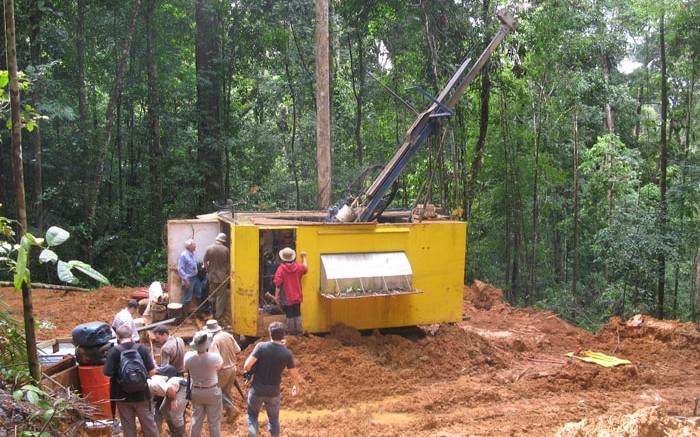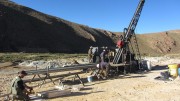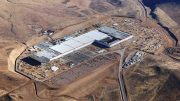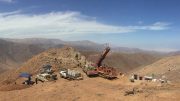A bankable feasibility study on the Montagne d’Or deposit in French Guiana envisions an open-pit mining operation that would produce 2.57 million oz. gold over 12 years.
Nordgold (LON: NORD), which has completed its earn-in option, owns 55% of the project, and Columbus Gold (TSX: CGT; US-OTC: CBGDF) owns the other 45%.
The remote deposit in northwestern French Guiana, 180 km west of the capital of Cayenne, would produce 214,000 oz. gold a year at life-of-mine total cash costs of US$666 per oz. gold and life-of-mine sustaining costs of US$779 per ounce.
The study outlined net initial capital costs (including pre-stripping and contingency, less surplus tax credit refunds) of US$361 million and an after-tax payback period of 1.4 years. Life-of-mine all-in sustaining costs are an estimated US$231 million.
An open-pit mine at Montagne d’Or would yield an after-tax net present value (NPV) at a 5% discount rate of US$370 million and an 18.7% post-tax internal rate of return (IRR), based on a US$1,250 per oz. gold price.
The study was completed under an accelerated time frame of three years.
Montagne d’Or has proven and probable reserves of 54.1 million tonnes grading 1.58 grams gold per tonne for 2.75 million contained oz. gold (a subset of the deposit’s measured and indicated resources of 85.1 million tonnes grading 1.41 grams gold per tonne for 3.85 million contained oz. gold). The estimates were based on a cut-off grade of 0.4 gram gold per tonne and a gold price of US$1,300 per ounce.

A drill crew at work at the Columbus Gold’s Montagne d’Or gold project in French Guiana. Credit: Columbus Gold.
The resource estimate followed 349 diamond core and reverse-circulation drill holes completed in two main campaigns. A previous property owner drilled 56 holes between 1996 and 1998, and Columbus Gold drilled another 293 holes between 2011 and 2016.
Now that the underlying economics of the project are understood, Columbus Gold says, more exploration will be done. Drilling is already underway on strike to the east and west, with one hole completed at depth beneath the pit.
In February, Columbus started an exploration program that consists of 36 core holes for a total of 5,520 metres. The program is designed as a first-pass investigation of exploration targets on strike of the project’s defined reserves.
The drill program will focus on four targets: the west strike extent of the deposit up to 1.25 km west of the current resource; the Gustave geochemical anomaly 500 metres east of the Montagne d’Or deposit, where a historic drill hole returned a 3.5-metre intercept of 31.94 grams gold; potential mesothermal quartz-gold vein systems within 1,000 metres north of the deposit; and under the deposit to test the downdip extent of the principal mineralized zones.
In addition, Columbus Gold and Nordgold are considering a near-term program to infill drill the higher-grade portion of nearly 1 million resource-pit-constrained inferred ounces. The US$1.5 million drill program could start as early as the second quarter of the year, pending drill permits.

Camp Citron at Columbus Gold’s Montagne d’Or gold property in French Guiana. Credit: Columbus Gold.
SRK has identified inferred resources within the resource pit of 960,000 oz. gold (20.2 million tonnes grading 1.48 grams gold) using a cut-off grade of 0.4 gram gold and a US$1,300 per oz. gold price.
“There are 960,000 inferred ounces that were never converted to a higher category because there was no time to infill drill,” Columbus Gold CEO Robert Giustra says. “We had a really tight time frame with a March 13 deadline to complete the feasibility study, and there was just no time to carry out the additional drilling of the inferred, which would have added more reserves. Adding those reserves with little to no effect on capex is going to result in a higher NPV and a higher IRR.”
Giustra notes that the inferred ounces sit right inside the resource pit. “It’s low-hanging fruit, and some of it is high grade,” he says. “Some parts of it average 1.8 grams per tonne, and a US$1.5-million drill program will convert 200,000 to 400,000 of those inferred ounces into reserves with little or no effect on capex, so it’s gravy.”
The partners say that certain capital costs in the feasibility study can be optimized. This could include getting better quotes from suppliers, pit optimization and lowering the cut-off grade used for reserves, if gold prices increase.
“There are savings and cost-cutting to be done, so the combination of it all, including more infill drilling, is going to lead to a better amended feasibility study late in the year,” Giustra says. “We hope to see an IRR of over 20% and a higher NPV — well into the US$400s.”
Columbus Gold is also evaluating interest in the project.
“It’s a compelling project and there are groups out there — commercial banks, streaming companies and private equity — that have expressed an interest in funding the construction of the mine,” he says.

Emmanuel Macron (left), then French Minister of Economy and now president elect of France, and Robert Giustra, Columbus Gold CEO, at the Montagne d’Or project in 2015. Credit: Columbus Gold.
The CEO notes that Emmanuel Macron, who was elected as France’s next president in elections on May 7, visited Montagne d’Or in 2015, when he was France’s Minister of Economy, and “expressed his strong support for the project.”
“It’s a strong endorsement of the economic development of French Guiana and the development of the gold industry in French Guiana,” Giustra says.
French Guiana, he explains, is a region of France, and Macron’s election “is clearly a good development for the prospects of a future mine at Montagne d’Or.”
In the feasibility study, the ultimate open-pit design has been separated into eight mine design phases for sequenced extraction for the mining production schedule, and has a stripping ratio (waste to ore tonnage) of 4.5 to 1.
The study’s mine production schedule is based on feeding the processing facility at a rate of 4.5 million tonnes per year (12,330 tonnes per day). However, ore will be mined in excess of that rate, so the marginal low-grade can be stockpiled and processed at the end of the mine life.
The mine plan consists of two years of limited pre-stripping (before processing ore), 10 years of open-pit mining, and two years of low-grade ore stockpile rehandling to feed the mill.
Montagne d’Or is 120 km by road from Saint-Laurent-du-Maroni, the nearest settlement. A 106 km, 90-kilovolt overhead power line is planned to connect the site to the existing power grid.
The project lies within the Guiana Gold Belt, which stretches from western Venezuela eastward through Guyana, Suriname and French Guiana, and into Brazil. Mineral deposits are typical of other greenstone terrains such as Canada, Australia and West Africa.
About 95% of French Guiana is covered by equatorial forest, and the country is home to one of the world’s largest biological reserves (644 sq. km), where mining is prohibited.
The boundary of the biological reserve comes to within 550 to 1,050 metres of Montagne d’Or’s southern boundary.
The project is situated in Zone 2 under the country’s mining legislation, which is open to prospecting as well as underground and open-pit mining.
The project is made up of eight mining concessions covering 190 square kilometres. Gold mineralization is hosted within a 400-metre-thick sequence of intercalated felsic, mafic volcanic and subordinate volcaniclastic rocks that strike east-west and dip steeply south.
The near-surface gold resources are contained within four closely spaced stratiform, subparallel, east- to west-striking and south-dipping sulphide mineralized horizons.
The deposit sits in the 150- to 250-metre-high Montagne d’Or in primary and secondary tropical forest. The game plan is to remove the cap of the mountain and continue to depth with an open pit.
Columbus Gold acquired the project in November 2010 and struck an option deal with Nordgold in late 2013.






Be the first to comment on "Columbus Gold, Nordgold complete feasibility study"